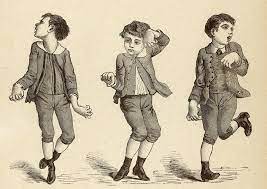 Chorea is an abnormal involuntary movement disorder.
Chorea is an abnormal involuntary movement disorder.
It is one of a group of neurological disorders called dyskinesias.
The term hemichorea refers to chorea of one side of the body, such as chorea of one arm but not both.
Chorea it is characterized by brief, semi-directed, irregular movements that are not repetitive or rhythmic, but appear to flow from one muscle to the next.
The dance-like movements of chorea often occur with athetosis, which adds twisting and writhing movements.
Walking may become difficult, and include odd postures and leg movements.
Unlike ataxia, which affects the quality of voluntary movements, or Parkinsonism, which is a hindrance of voluntary movements, the movements of chorea and ballism occur on their own, without conscious effort.
Chorea is a hyperkinetic movement disorder.
When chorea is serious, slight movements will become thrashing motions; this form of severe chorea is referred to as ballism, or ballismus.
Chorea usually local lies to extra parameter basal ganglia networks.
Huntington’s disease is a neurodegenerative disease and is the most common inherited cause of chorea.
Other genetic causes of chorea are rare: inherited prion disease, the spinocerebellar ataxias, neuroacanthocytosis, dentatorubral-pallidoluysian atrophy, brain iron accumulation disorders, Wilson’s disease, benign hereditary chorea, Friedreich’s ataxia, mitochondrial disease and Rett syndrome.
The most common acquired causes of chorea are cerebrovascular disease and, in the developing world, HIV infection, usually through its association with cryptococcal disease.
Sydenham’s chorea occurs as a complication of streptococcal infection.
Twenty percent (20%) of children and adolescents with rheumatic fever develop Sydenham’s chorea as a complication.
It is increasingly rare: penicillin, improved social conditions, and/or a natural reduction in the bacteria (Streptococcus) it has stemmed from.
Chorea gravidarum refers to symptoms that occur during pregnancy.
The disease resolves in 30% of patients before delivery but, in the other 70%, it persists.
The symptoms then progressively disappear in the next few days following the delivery.
Chorea may also be caused by drugs: levodopa, anti-convulsants and anti-psychotics.
Other acquired causes include CSF leak, systemic lupus erythematosus, antiphospholipid syndrome, kappa light-chain monoclonal gammopathy of undetermined significance, thyrotoxicosis, polycythaemia rubra vera, transmissible spongiform encephalopathies, coeliac disease and gluten ataxia.
Treatment
There is no standard course of treatment for chorea.
Huntington’s-related A common treatment is dopaminergic antagonists, although treatment is largely supportive.
Tetrabenazine is the only FDA approved drug for the treatment of Huntington’s disease-related chorea.
Sydenham’s chorea-Haloperidol, carbamazepine and valproic acid. Usually involves antibiotic drugs to treat the infection, followed by drug therapy to prevent recurrence.
Chorea gravidarum haloperidol, chlorpromazine alone or in combination with diazepam, also pimozide can also be used.
Wilson’s disease -Reducing levels of copper in the body using D-penicillamine, trientine hydrochloride, tetrathiomolybdate, and other chelating agents
Drug-induced chorea Adjusting medication dosages.
Metabolic and endocrine-related choreas-Treated according to their causes.
